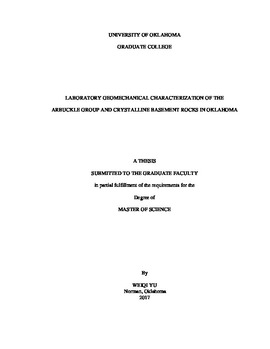| dc.description.abstract | In the past decade, the rapidly increase in earthquakes in the State of Oklahoma has drawn serious attention. Some investigations have attributed the increased MEQ to the large amount of wastewater injections as part of hydrocarbon production. The crystalline basement of Oklahoma and the Arbuckle Group, which are situated above the basement rocks, have been considered among the most important geological sequences since they were identified as the major disposal zone and seismic hazard zone. Modeling and analysis of MEQ requires a good understanding of rock and fracture characteristics. Although preliminary research efforts have aimed to understand the injection induced seismicity problems, the laboratory characterizations of the geomechanical and petrophysical properties of the rock from these layers are rear.
In this study, a laboratory characterization program has been carried out to determine the much needed rock elastic properties, strength properties and fracture properties of the Arbuckle Group and two types of crystalline rock, Troy granite and Roosevelt gabbro from its bounding basement. A series of laboratory techniques, such as ultrasonic velocity measurements, multistage triaxial compression test, and multistage shear test have been performed on multiple one-inch right circular cylindered specimens extracted from outcrops and quarries of these geological sequences. In addition, the relations among the measured properties, such as the static and dynamic elastic constants and the mechanical anisotropy have been explored and discussed.
Samples from both the Arbuckle Group and the crystalline basement have been characterized and show to be strong, with a high density of 2.61 to 2.68 g/cc for the Arbuckle limestone and Troy granite, and more than 2.80 g/cc for the Roosevelt gabbro. The samples show high hardness index of more than 600, 700, and 800 for Arbuckle limestone, Roosevelt gabbro and Troy granite, respectively. High Young’s modulus are also the case with 100 GPa for Roosevelt gabbro, and about 60 – 80 GPa for others. The Troy granite is the strongest material with extremely high compressive strength; and the Roosevelt gabbro has the highest stiffness. Furthermore, to characterize the rock joint properties, Barton’s shear strength criterion has been deployed. All the fractures have small JRC values, typically 0.2, from back-analysis. The JCS values were obtained and are similar to the UCS determined for intact samples, indicating low level of weathering. The shear stiffness values increase with confining pressure and the Arbuckle limestone tends to have higher stiffness values than the other tested rocks from the basement. | en_US |
